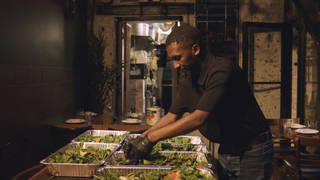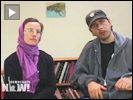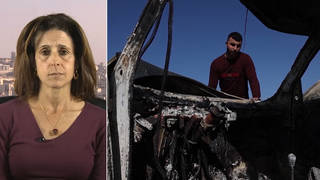
Topics
Guests
- Jonathan PollakIsraeli peace activist.
- Daniel ArgoIsraeli doctor who regularly takes part in the demonstrations against the West Bank separation wall.
A Palestinian woman died Friday after Israeli forces shot her with tear gas during a peaceful protest against the West Bank separation wall in the village of Bil’in. Israeli and Palestinian eyewitnesses, as well as staff at a hospital in Ramallah, say that Jawaher Abu Rahma died after inhaling massive amounts of tear gas fired by the Israeli military at the demonstration. She was 36 years old. We speak with an Israeli activist and an Israeli doctor who were at the protest. [includes rush transcript]
Transcript
AMY GOODMAN: A Palestinian woman died Friday after Israeli forces shot her with tear gas during a peaceful protest against the West Bank separation wall in the village of Bil’in. Israeli and Palestinian eyewitnesses, as well as staff at the hospital in Ramallah, say that Jawaher Abu Rahma died after inhaling massive amounts of tear gas fired by the Israeli military at the demonstration. She was 36 years old.
Unnamed Israeli military officials are now seeking to cast doubt on the claims. They are quoted in Agence France-Presse and the Israeli newspaper Ha’aretz saying there is no evidence Jawaher died from inhaling tear gas or that she even participated in Friday’s demonstration.
The tear gas used by the Israeli forces was reportedly manufactured by Combined Systems, a U.S. company based in Jamestown, Pennsylvania. We contacted the company to invite them on the program or to get a statement, but they didn’t respond. We also contacted the Israeli embassy in Washington to invite them on the show, but they denied our request.
We’re joined now by two guests who were at the protest on Friday. Jonathan Pollak is an Israeli activist who says he saw Jawaher at the protest. He joins us by Skype from Jaffa. And joining us on the telephone from Jerusalem is Daniel Argo, an Israeli doctor who was also at Friday’s protest.
We welcome you both to Democracy Now! Jonathan, we want to begin with you. Since unnamed sources in the Israeli military are denying that Jawaher was even at the protest, did you see her there?
JONATHAN POLLAK: I did see her at the beginning of the protest, and I did see the ambulance evacuating her. It’s important for me to say that these are completely unsubstantiated reports coming from, as you said, anonymous sources. We have numerous eyewitnesses all attesting to her being there or attesting to her being hurt by tear gas. We have the ambulance driver who evacuated her saying that he evacuated her from the area of the demonstration and that she was semiconscious when she got to him and told him she had breathed tear gas, that her injury was a result of tear gas inhalation. We also have the medical reports that suggests — that clearly say that she had died as a result of a cardiac arrest as — a cardiac arrest caused by tear gas inhalation. We also know that she died in the hospital, from the hospital reports. I also know it personally, because I spoke to people at the hospital all night long.
This is outrageous, basically. What the army — what the IDF is saying is outrageous. They’re spreading rumor without any fact. If you ask me, this is not even newsworthy. And yet, people keep on reporting it.
AMY GOODMAN: Reporting that unnamed sources are saying this?
JONATHAN POLLAK: Yes. Well, unnamed sources in the army, and they’re reporting it as news. This is the news that opened Israeli news last night. This is in all the Israeli newspapers, with front-page — in the front page, a version that is completely not based on any fact and is only based in rumor. And the only reason that they publish it is because the army says so. And we, on the other hand, our version is completely backed by fact and by evidence, but it is only provided as a response.
AMY GOODMAN: Can you tell us who Jawaher Abu Rahma was, her brother killed a year ago in a similar protest in a similar place, protesting the separation wall in Bil’in?
JONATHAN POLLAK: Well, they were actually both killed in pretty much the same place, near the separation barrier in Bil’in. Unfortunately, I didn’t know Jawaher herself very well. I knew the family pretty well. So I can’t tell you much about her. I can tell you that her family, her entire family, is very involved in the struggle. As you said, her brother was killed last year after an American-made tear gas projectile, high-velocity tear gas projectile, hit him in the chest, a tear gas projectile that was shot, in contradiction to manufacturer orders, directly at him from short distance — killed him on the spot.
Her other brother, Ashraf Abu Rahma, was filmed also about a year ago — two years ago, actually, was shot — was filmed being shot by an Israeli soldier at the direct order of a high-ranking Israeli commander, when he’s bound and blindfolded, shot with a rubber bullet from a very short distance that hit him in the foot. So, this is her family.
AMY GOODMAN: And we have shown, actually, the video of her brother shot and dying.
JONATHAN POLLAK: It was a shocking video that made it to news editions across the world.
AMY GOODMAN: Dr. Daniel Argo, you are an Israeli doctor. You also were at the demonstration against the West Bank separation wall in Bil’in. In fact, you — can you talk about the tear gas that was used?
DR. DANIEL ARGO: Yes, of course. On Friday, the last Friday demonstration, the Israeli army shot, almost as usually, large amounts of tear gas at the demonstration from its very beginning. We know that Israel is using in Bil’in and in other villages and towns in Palestine tear gas, which is called CS, which is the oldest tear gas on the market. And this tear gas is well known, for the last 80 years, to cause — that it may cause severe injuries and even death. The Israeli army, the same anonymous officers in the Israeli army, claimed in the last several days that they are not aware of any significant injuries or deaths occurring because of tear gas. But the facts are against them. They are very well aware of the history of this tear gas. They even know that there — that the Israeli army itself published articles saying that this tear gas might cause fatal injuries. And unfortunately, that happened again in the last Friday.
AMY GOODMAN: Let me ask you about this issue, an Israeli official contending tear gas disperses rapidly in the air over open ground, it does not kill protesters, again questioning whether Abu Rahma was even at the December 31st demo.
DR. DANIEL ARGO: This is against — this is totally different from all the researches and all the reviews that are being made in the medical — in different medical journals. Just a year and a half ago, one of the best medical journals in the world, the British Medical Journal, published a big article about the dangers of using different tear gases, and especially put emphasis on CS gas, saying that it might cause severe injuries and even death. From what I heard and from evidence that we had about the death of Abu Rahma, it seems as if — that her injury and her death was the consequences of tear gas injury. And that would not be the first case, not in the medical history, and unfortunately not in Palestine, as well.
AMY GOODMAN: Dr. Argo, considering how much tear gas we see they used, why would only she die or be affected in this way?
DR. DANIEL ARGO: I think we can somehow compare it maybe to, for example, for different medications or to different toxins that are being used. Not every person who is being exposed to any compound would react the same way. Some would develop some side effects; some might not develop any side effects at all. Even more, a person can develop side effects to a tear gas, very slight side effects, and in the next week develop a much harder reaction to a tear gas. This is something that is well known. It depends also on intrinsic factors like a person’s health history, his age, but especially it is dependent on the amount of gas particles per square meter and the amount of tear gas particles that the person is being exposed to.
We know that there is different limitations on tear gas use being implied in different countries. And until now, the Israeli army don’t have any limitations on using this tear gas, as every Friday in Bil’in and in other villages in Palestine, Israeli army shoots large amounts of tear gas at the protesters, near houses, sometimes even inside the houses. And this is something that is well known as something that can cause severe injuries and even death.
AMY GOODMAN: Dr. Argo, you started training people a year ago dealing with tear gas at these protests, after Jawaher’s brother Bassem was killed?
DR. DANIEL ARGO: Unfortunately, in the last several years, there were 21 demonstrators killed and many more injured in the demonstrations, not only because of — not only by tear gas, but by rubber-coated bullets and even live ammunition. And unfortunately, we needed to find a way to deal with it, as well. The Palestinian ambulances and hospitals are doing a great job. I also tried to help activists to be able to deal with this. And in the last years, I, myself, and other people treated many people who have been injured by tear gas. We see many delayed effects of this gas — respiratory problems, eye and skin diseases — that most probably, and from medical literature, may be related to tear gas and especially CS gas exposure.
AMY GOODMAN: And then, of course, there are those who are injured by the tear gas canister, like the student here at Cooper Union in New York, Emily Henochowicz, who protested the Israeli assault on the Mavi Marmara at Qalandiya checkpoint last year. She had gone from New York to the West Bank. And then there was Tristan Anderson, who just came home, the American photographer and activist who was at a protest, and he was shot in the eye and is severely maimed by this.
DR. DANIEL ARGO: Yes. As I said, unfortunately, we see so many people who are going to nonviolent demonstrations, and they’re coming home very injured or even not coming back home at all.
AMY GOODMAN: Jonathan Pollak, you’re speaking to us from Jaffa. You are free today, but you’ve been sentenced to three months in prison. You’re an Israeli peace activist. Why are you going to jail?
JONATHAN POLLAK: I’m going to jail, officially, because I rode my bicycle in Tel Aviv in a protest against the siege of Gaza. But I think it should be very obvious that my imprisonment — despite the fact that it gains quite a lot of attention, my imprisonment should be taken in context. And the context is that of a crackdown on the popular — on the Palestinian popular resistance and its support by internationals and Israelis. Dozens and dozens of people are going to jail here for much longer periods of time for similar accusations.
Palestinians are tried in military courts, under military law. We have two different legal systems here. It’s a fact that most people do not know. We have two different legal systems here: one for Palestinians and one for Israelis, in the West Bank. And unfortunately, many of us, the vast majority of Palestinians, of course, are being sent to jail for our resistance to — our unarmed and civil resistance to the occupation.
One thing I wanted to add about the Bil’in incident is that the — is, again, a little bit of context. What happened on Friday was a pretty ordinary event. We marched from the center of the village towards the wall. It was a bigger demonstration than usual. There were about a thousand people. But the army began shooting towards us, shooting tear gas towards us, on sight, when we were hundreds of meters away from the wall, simply to disperse us. And they blanketed the entire area. This is a very big open area. They blanketed it with tear gas in a way that allowed no one to escape. And this is the context in which Jawaher was killed in.
AMY GOODMAN: Why were you protesting the wall?
JONATHAN POLLAK: I am — generally, I protest the wall for a few reasons. First of all, I believe that it is a mechanism of perpetuating the occupation and of strengthening Israeli control over Palestinians. It is also an instrument of land grab. In this specific case, even the Israeli Supreme Court recognized the fact that the specific path of the wall in Bil’in is an instrument of land grab for the expansion of Jewish settlements, of Jewish-only settlements. The Israeli Supreme Court had even ordered, more than three years ago, that the path of the wall should be dismantled. Despite that fact, the path of the wall still stands in its original position. And despite the fact that it still stands in its original position, in contradiction to the military court — to the Supreme Court’s order, the army continues to disperse, to violently disperse, demonstrators.
AMY GOODMAN: Actually, we should step back a minute. For people who are unfamiliar with this separation wall, explain exactly how large it is, where it extends, why this has become such a focal point of protest.
JONATHAN POLLAK: The separation barrier is one of the most substantial instruments of occupation in recent years, maybe only can be compared to the Israeli Jewish-only settlements in the West bank. It is — the border, the internationally recognized border of Israel, the 1949 Armistice line, is about 300 kilometers, 350 kilometers. The path of the wall is nearly 700 kilometers long, more than twice the length of the recognized border. The reason for that is that it intrudes deep into the West Bank, taking over a lot of Palestinian land in the interests of settlement and settlement expansion. And it also is an instrument in the Israeli policy of dividing the West Bank into several main bantustan-like areas that are not immediately connected and could be divided on any Israeli whim.
AMY GOODMAN: And Dr. Daniel Argo, you were there both as a doctor and also protesting the wall. Can you talk about why you are going to these protests over and over again? And what is the reaction of the Israeli population to your protesting?
DR. DANIEL ARGO: I think most of the reasons that Jonathan talked about are the main political reasons, but I think that there is another important aspect, and this is combined Israeli-Palestinian political activity. The wall, besides being an obstacle for normal life in Palestine, it also serves in many ways as a separation between — trying to hide Palestinians as far away as the Israeli government can. And I think these weekly demonstrations in Bil’in and in other villages and in East Jerusalem, ones that combined Palestinian, Israeli and international activists, is the strongest political statement that we can make. And this is a statement that takes up — takes apart all the fears and all the panic that the Israeli government trying to put on every day. And the most simple act of Israelis and Palestinians demonstrating together, meeting together, on a weekly and many times on a daily basis, this is something that shows that even politics in the Middle East are possible. This is, for me, the very important thing.
AMY GOODMAN: Well, I want to thank you both for being with us. And finally, Jonathan Pollak, when are you going to jail?
JONATHAN POLLAK: In exactly a week, on the 11th.
AMY GOODMAN: Jonathan Pollak, Israeli peace activist, Dr. Daniel Argo, Israeli doctor who regularly takes part in demonstrations against the West Bank separation wall — they were both in Bil’in when Jawaher Abu Rahma died after inhaling massive amounts of tear gas shot by Israeli forces. She died in the hospital in Ramallah.












Media Options